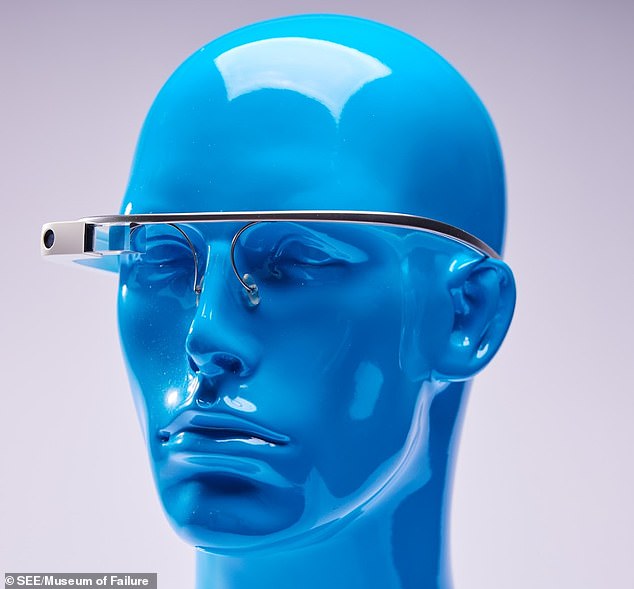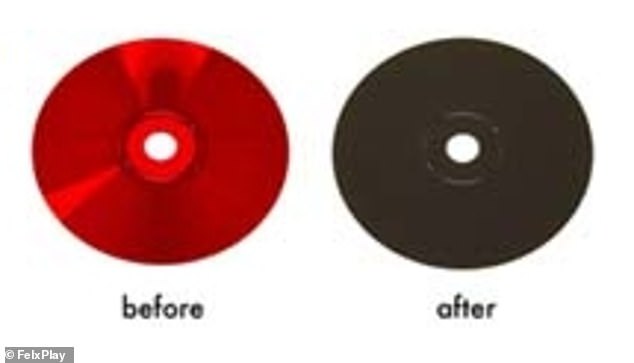For every successful product that hits the market, there are several others that flop – and an exhibit showcasing over 159 of these failed innovations opened Friday in New York City.
The Museum of Failures, located in Brooklyn, features over 159 failed products and services like Google Glass Glasses, a Barbie doll that grows breasts and self-destructing DVDs.
Founder Samuel West said he created the exhibit to help the public learn from failure, which is ‘an essential aspect of progress and innovation.’
The showroom features items from big tech names like Apple, Google and Microsoft, but there are also food products like Crystal Pepsi and fat-free Pringles that missed the mark in the market.
DailyMail.com has picked out seven of the weirdest failed items on display.

Growing Up Skipper was released in 1975, but was discontinued in 1977. The doll would sprout breasts when its arm was turned
The Museum of Failures opened at Industry City and will be on exhibit until May 14.
The venue, located within Industry City, is between 33rd and 34th Streets at 900 Third Avenue, Brooklyn, NY 11232.
Jim Somoza, Managing Director, Industry City, said in a statement: ‘Industry City represents a diverse community of forward-thinking companies built on the idea of innovation and experimentation, much like the Museum of Failure.
‘Thinking outside the box and risking failure is often the only path to success. We look forward to welcoming this exhibit back to the US.’
Growing Up Skipper
Mattel released Barbie’s little sister in 1975, but she came with some growing pains that were not welcomed by parents who purchased the doll for their child.
Growing Up Skipper was designed to bloom when you rotated her left arm clockwise, which triggered breasts to sprout from her rubber chest and her waste to expand by an inch.
The slogan was ‘Two dolls in one for twice the fun,’ but was seen as a toy by Mattel was viewed as perverted by the media.
A coalition of Connecticut women’s groups protested the doll, urging manufacturers to stop advertise a doll that ‘matures’ when its arm is twisted.
‘It is destructive to the image of women,’ the Connecticut Feminist Committees Media Reform said in 1975.
Growing Up Skipper was discontinued in 1977.
Google Glass

Google Glass hit the market in 2012 for $1,500, but fell flat due to privacy, legal and safety concerns. Googled ended sales in 2015
Google Glass was publicly revealed in April 2012 to much fanfare as ‘smart glasses’ that could display information alongside what the wearer sees using an optical head-mounted display.
A prototype version was made available in April 2013 for a limited period before becoming more widely available in May 2014 for $1,500.
However, Google Glass soon became a lightning rod for criticism, particularly regarding privacy, legal and safety concerns.
The criticisms, alongside other issues that hampered the product such as a high price tag and software problems, prompted Google to end consumer sales in January 2015.
Google in 2019 launched a pair of $999 smart glasses for businesses that look like a pair of traditional specs, rather than futuristic headgear.
Flexplay DVDs
Released in 2003, Flexplay had opened its disposable DVDs would revolutionize the way people watch movies.
The company developed ‘self-destructing’ video discos that would turn from red to black in 48 hours of being removed from the packaging.

FlexPlay had hoped to revolutionize the way people watched movies when it released its ‘self-destructing’ DVDs in 2003

The video discos would turn from red to black in 48 hours of being removed from the packaging. It failed to gain popularity and was discontinued in 2008
The DVDs were ‘made with a special glue that is sensitive to oxygen. Once the disc is exposed to air, a chemical reaction causes the glue to darken,’ TIME reports.
The discs cost $7 each, which was more than a rental from BlockBuster at the time and although cheaper than buying a traditional DVD, FlexPlay’s was unusable after two days.
Not only did it flop among consumers, but environmental groups were also not fans of the disposable disc.
And in 2008, FlexPlay pulled its ‘innovation’ from the market for good.
Hawaii Chair
The Hawaii Chair was released in 2007, which promised users a slimmer waste by forcing them to hula as they sat.
According to Perfect USA website, the Hawaii Chair ‘combines the ancient art of the Hula of the Hawaiians with an easy-to-use, fun exercise machine.’
Users’ hips gyrate as the seat rotates clockwise and counterclockwise at the desired speed.

Perfect USA’s Hawaii Chair, released in 2007, promised to slim the waist by forcing users to do the hula dance, but consumers realized it failed to deliver
The website states that ‘the Hawaii Chair’s exercises strongly affect your waist, buttocks and thighs to thaw and loosen redundant fat.
‘After using the Hawaii Chair, you will have a narrow and well-defined waist.’
The electric-powered chair offers nine speeds that does the work for users, ‘without strenuous exercising, for anyone who wants to achieve a good waistline and maintain a fit body.’
The $350 gadget soared in popularity when it appeared on ‘The Ellen DeGeneres Show’ in early 2008, but it slowly loss the market when consumers realized it was not the fitness wonder it had claimed to be.
It is not known when Perfect USA discontinued its chair, but they are no longer available for purchase.
Nintendo Power Glove
The Power Glove, released in 1989 for $100, was a virtual reality gaming controller for the Entertainment System (NES).
The device detected wrist tilt and finger wiggles that were transformed into action in a video game.

The Power Glove, released in 1989 for $100, was a virtual reality gaming controller for the Entertainment System (NES). However, it did not actually work and was discontinued five months later
It gained popularity when shown in the 1989 film ‘Wizard,’ which so happened to hit theaters right before Christmas.
Shortly after launch, Mattel reported it sold 100,000 units – a major win for the company.
However, problems surfaced when gamers realized the Power Glove did not work.
Consumers found it was hard to control and connecting to the gaming console.
And in just five months after launch, the Power Glove was no more.
Rejuvenique Face Mask
Rejuvenique Face Mask, launched in 1999, straps onto your head and tightens facial muscles using electrical stimulation.

Rejuvenique Face Mask: The device, launched in 1999, straps onto your head and tightens facial muscles using electrical stimulation. It claimed your skin would be youthful in just 12 weeks. The FDA declared it unsafe and it was pulled from the market
The company said users should use the mask for 15 minutes at least three times a week and it was ‘clinically proven’ to improve skin elasticity, reduction of crows feet, rinks and give you beautiful skin tone in just 12 weeks.
The Rejuvenique Face Mask required a nine-volt battery and came with a VHS owner’s manual. It was sold for around $400.
However, the Food and Drug Administration (FDA) declared the mask unsafe in 2000 and, one year after it launched, stated that without FDA approval, ‘marketing Rejuvenique is a violation of the law.’
The ‘specially designed gold-plated facial cushions’ claimed to provide a workout for all 12 of your ‘facial zones’ to give you a youthful look.
Crystal Pepsi
Crystal Pepsi, which tastes like regular Pepsi but has no caramel coloring, debuted in test markets on April 13, 1992 before a nationwide rollout in December of that year.

Crystal Pepsi, which tastes like regular Pepsi but has no caramel coloring, debuted in test markets on April 13, 1992 – and was pilled a year later
It came at a time when food and beverage companies were thinking out side the box to outsmart the competition.
The colorless soda was developed with help from a food scientist named Surinder Kumar, who was behind Nacho Cheese Doritos.
Pepsi did a soft launch in select US cities, including Denver and Sacrament, and received positive reviews of the new soda.
Crystal Pepsi amounted to around $474 million in the first season and Coca-Cola retaliated with Tab the next year.
Coca-Cola has admitted that it made Tab in order to kill Crystal Pepsi – but Pepsi’s own product took itself out.
People were not interested once they learned it tasted like the original, dark soda – but not enough like Pepsi.
Crystal Pepsi was discontinued a year later in late 1993.










